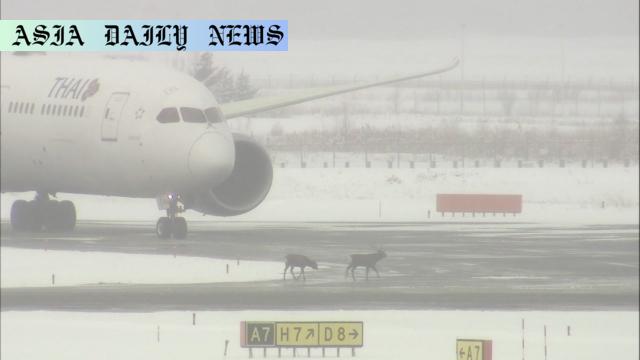Deer Intrusion: Hokkaido’s New Chitose Airport temporarily closed runways after two deer caused disruptions to flight operations.
Deer Intrusion caused a temporary shutdown of runways at New Chitose Airport in Hokkaido.
Four flights changed destinations, and three others had to execute go-arounds due to the incident.
Runway operations resumed within 50 minutes after the deer were driven away.

Deer Intrusion Causes Flight Disruptions at Hokkaido Airport
On Thursday morning, flight operations at Hokkaido’s New Chitose Airport were temporarily disrupted due to an unusual incident involving wildlife. Two deer were spotted on the airport premises, triggering a swift safety protocol by the airport operator, Hokkaido Airports, which resulted in the temporary closure of both runways. This episode unfolded shortly after 10 a.m. local time, highlighting the potential challenges of maintaining wildlife management at aviation hubs.
The presence of the deer prompted Hokkaido Airports to take immediate action to mitigate any risks to passenger safety and aircraft operations. Wildlife intrusion at airports can result in significant hazards, with the possibility of dangerous animal-aircraft collisions. Footage from NHK’s camera system captured the two deer moving near taxiing aircraft at around 10:30 a.m., showcasing the urgency of the situation.
Impact on Flights and Operations
During this period, a series of flights experienced disruptions despite the relatively brief 50-minute closure. According to Hokkaido Airports, four flights had to divert to alternate destinations, while an additional three flights were required to make go-arounds, delaying their landings. Such disruptions underscore the ripple effects even small-scale incidents like this one can have on air traffic and passenger travel plans. The resumption of normal operations by 10:50 a.m., however, restored some level of normalcy.
Hokkaido Airports has not disclosed specific details about the procedures used to remove the deer from the premises but emphasized their efforts to prevent similar occurrences in the future. This event has triggered conversations regarding the efficacy of fencing systems and wildlife control measures at airports, particularly those near forested or rural locales, which are more prone to such incidents.
The Wider Implications for Aviation Safety
This incident highlights the broader, ongoing challenges faced by airports located in regions rich in wildlife. Airport authorities in such places must routinely engage in wildlife hazard management, employing measures such as installing robust fencing systems, conducting regular surveillance, and implementing advanced deterrent technologies. Although wildlife intrusions of this nature are uncommon, they serve as critical reminders of the necessity for vigilance in mitigating risks related to aviation safety.
The case of New Chitose Airport also underscores the importance of communication and efficiency in handling unforeseen disruptions. By quickly deploying teams to address the situation and relaying updates to passengers and airline operators, the airport managed to minimize delays and operational setbacks. Nonetheless, it reveals the need for continuous innovation and investment to ensure the compatibility of wildlife conservation efforts with modern aviation infrastructure.
Looking Ahead
As instances of wildlife intrusions have global parallels, particularly in regions with high biodiversity, this event at New Chitose Airport serves as a case study for the aviation industry. By studying such situations, the industry can explore enhanced preventative measures and reactive protocols to ensure stricter safety standards and limit disruptions. Hokkaido Airports might consider integrating advanced monitoring technologies, such as motion-activated sensors or sound deterrents, that are designed to keep runways clear of animals while avoiding harm to the local ecosystem.
Incidents involving wildlife at airports serve as reminders of the delicate balance between human infrastructure and nature. By addressing these challenges, airports can continue to prioritize passenger safety while fostering a coexistence with the natural world.



Commentary
A Closer Look at the Incident
The recent deer intrusion at Hokkaido’s New Chitose Airport provides an intriguing example of the myriad challenges faced by modern aviation. While incidents involving wildlife may seem trivial when compared to other aviation safety concerns, they are a stark reminder of the unpredictability of nature and its potential impact on human activities. Airports, particularly those located in areas rich with fauna, must confront these challenges with a blend of vigilance, adaptability, and technological innovation.
The Importance of Wildlife Management
Wildlife management in the aviation sector remains a critical yet under-discussed aspect of operational safety. This incident exposes the vulnerabilities of even the most well-planned aviation hubs to the natural world. New Chitose Airport’s ability to quickly mobilize resources and resume operations within a hour demonstrates strong procedural preparedness, yet it also raises questions about long-term mitigation strategies. Could more advanced motion-detection systems or more effective barriers prevent future disruptions of this nature?
The Ripple Effects of Disruptions
Beyond the immediate inconvenience of delayed or diverted flights, cases like this highlight the dependency of modern life on complex interlocking systems. A small incident, such as two deer wandering onto a runway, cascades into operational, financial, and personal consequences for many hundreds of people. While passengers may find themselves irritated by delays or disruptions, incidents like this serve as a moment to reflect on the interconnectedness and fragility of the systems that power our daily lives.
Overall, the deer intrusion reminds us of the constant balancing act between maintaining infrastructure and respecting the natural world. The aviation industry, as well as other sectors, can take this event as an opportunity to strengthen and innovate safety measures while ensuring harmony with local ecosystems. By doing so, they can minimize disruptions and create a safer, more reliable future for all stakeholders.